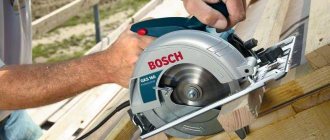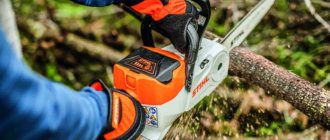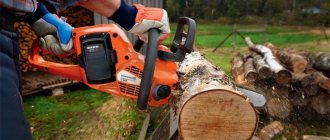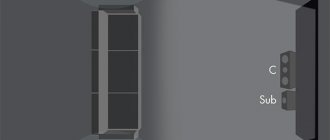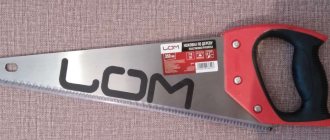Jigsaw blades
If you have previously worked with a jigsaw, then you know that if you use the wrong saw, you can ruin the top layer of the material, especially for layered material.
Plywood is a layered material - it is wood veneer glued together. In this section we will look at how saw blades affect the quality of the cut and what types they are in principle.
Files come in different tooth sizes and shapes, the length of the file, the material for which they are intended, the direction of the tooth, the material from which the file is made and for what purpose it was developed. For example, a blade with a large tooth is designed for cutting wood at high cutting speed for rough cuts. And files with shorter teeth will make a more even cut. Thin (narrow) files make it possible to cut radius and other non-standard shapes, while wide ones help to maintain a straight cut.
The letters “A, B, C, D” indicate the size of the teeth, the letter “A” indicates that the saw has the smallest teeth.
The numbers indicate the length of the file 1, 2, 3, 7, the length of the blade, the longer the file, the thicker the material it can cut.
For example, the marking of Bosch brand files looks like this:
An engineer’s personal experience about jigsaw files:
In production, there are tasks both for an even saw when working with finished portraits, and the need to unravel a large sheet of plywood, when speed is required and quality is not so important. The majority of sawing blades are designed for speed, not quality of cut.
And even files with a medium tooth will scratch the surface of the material, i.e. spoil the top layer of plywood. Not so much compared to larger tooth files. Therefore, the engineer adapted himself to using metal files with fine teeth up to 1 mm for even cutting of plywood. When working with such a file, the speed suffers greatly and these files become very hot. But when important cutting work is needed, the time spent is justified. An engineer uses such saws when he needs to work on a portrait that has already been burned out.
We cut wood materials
Cutting wood and everything made from it is the main purpose of a jigsaw. Therefore, a larger range of saw blades are produced specifically for wood and are divided by type of work.
Fast cut
Certain wood construction jobs don't require much care, such as sawing lumber for sheathing or removing an old window frame. What is more important here is the speed provided by fast cutting blades with characteristic features:
- Large teeth - up to 6 mm.
- A fair amount of separation - about 1 mm.
- Long blade - from 60 mm.
- Width - up to 10 mm.
For thick workpieces, similar blades with large cutters are used, but without routing - they deviate less from the vertical. In principle, the thicker the file, the better it maintains perpendicularity.
Advice. A blade with an oblique tooth is better suited for cutting along the grain, and a blade with a straight tooth is better suited for a cross cut.
Clean cut
An operation such as cutting furniture panels or parquet boards requires a smooth and precise cut. Such tasks are performed with less productivity, but with better quality, using blades for clean cutting that have:
- Teeth less than 3 mm.
- Minor divorce.
Most of the saw blades cut by retraction, so the material is placed with the reverse side. To mark and cut from the face, you need a blade with a reverse tooth. It is not very convenient for them to work - in addition to maintaining the direction of the cut, they have to overcome the force of pushing out the tool.
Advice. A specialized saw with two rows of teeth allows you to cut panels laminated on both sides almost without chipping.
Curly cut
It is problematic to cut out small radii with a wide blade. Files for figured cutting have a beveled back side, making it easier to turn, they can be rounded without chipping and differ in appearance:
- Small (up to 2 mm) tooth.
- Narrow working part - up to 4 mm.
- Small length - up to 40 mm.
Which jigsaw is best for sawing?
In principle, laminate can be cut with any working jigsaw.
It is important to use a high-quality, suitable file. However, it is more convenient and more productive to work with a high-quality professional tool, especially for large volumes of work.
Domestic models overheat faster when working for a long time and require a break from work to cool down. Ergonomics is also important. A jigsaw must not only be professionally reliable, but also powerful enough. At the same time, it is not too heavy, with a comfortable center of gravity, handles and visibility of the sawing field. The most advanced in terms of convenient ergonomics and weight are jigsaw models from Japanese brands (Makita, Hitachi).
The speed of the blade matters - the higher it is, the cleaner the cut. Some models have a maximum of 3200 up/down cycles per minute. Others - 3500 cycles/min. But, some materials are cut better not at maximum speed, but at optimal speed, which is selected by adjusting the speed and trial sawing.
Laminate cutter
Another tool designed for cutting laminate flooring is a cutter that works on the principle of a guillotine. In other words, it is a sharp knife that, with the help of a handle, is lowered onto the board and smoothly cuts it. To work with the cutter, no skills or force are required; the cut is very high quality, smooth, without chips, and the process itself proceeds without noise or dust.
With the help of a cutter you can easily achieve a perfect, professional-quality result. But it is advisable to use this tool specifically for professionals, since it has a narrow specialization and is intended only for cutting laminate. Therefore, to repair two or three rooms, it makes no sense to purchase this tool.
Another disadvantage is that it is impossible to cut the laminate panel along the canvas, but only across it.
Many people, starting to renovate their apartment with their own hands, simply do not know how to cut laminate flooring. As it turned out, the most convenient and easy-to-use tool is an electric jigsaw.
If you follow certain rules, you can quickly learn and achieve good results. Each of the tools discussed above has some advantages over the others - the choice must be made in accordance with professional skills.
How and with what to cut plywood without chipping
Anyone who is going to create an interior item from a plywood sheet, for example, a stool, a carved box, a wardrobe or a rocking chair, is wondering what needs to be taken into account when working to make the product reliable and attractive? Many people are also interested in how to cut plywood (with a jigsaw or saw).
The cutting of sheet material must take place on a strong installation to avoid instability of the processed area
To answer the question of what is the best way to cut plywood and how to do it correctly, before work you need to familiarize yourself with all the nuances and subtleties that should be taken into account in the process in order to achieve a positive result.
If you take into account all the subtleties and nuances when working, then the result of all negative aspects can be avoided.
What not to saw
Due to the combined structure, it is difficult to cut laminate without chipping. But with the right approach, this is possible at home with improvised means.
With a large volume of work, some craftsmen saw laminated boards using a grinder. Nozzles for wood are selected. To make cutting easier, a bar is installed along the cutting line. It is not recommended to cut laminated boards with a grinder or angle grinder, as this can cause injury.
Choose a tool according to your capabilities.
What not to cut chipboard
If the volume of work is large enough and the quality requirements are low, some craftsmen advise sawing chipboard at home using a grinder (angle grinder, commonly called an “grinder”). In doing so, they use a disk designed for working with wood. To make cutting easier, a guide bar is secured along the cutting line using clamps. Cutting chipboard using a grinder can sometimes be seen in the video.
Attention, important! This method is absolutely unacceptable, since the likelihood of injury during operation is very high, especially if large diameter discs are used and the protective casing is removed from the grinder
Using a hacksaw
Sawing with a hacksaw at home is quite difficult. First, you need to cut the measuring line with a knife and glue tape along it. This will protect the top layer from damage. Point the tool at an angle of 30 degrees. Carefully move the hacksaw back and forth without pressing hard. To cut laminated chipboard without chipping with a hacksaw at home, choose devices with the finest teeth. In case of damage, the cut area must be passed with a file, directing it from the edge to the center. Finally, rub with sandpaper (fine-grained) and hide the defects under the flexible profile.
Marking the cut line
To cut the material evenly with a jigsaw, you need to correctly mark the cutting line and securely fix the workpiece on the surface. If you have to work with a long blade, you should use a flat rail as a guide and two clamps to secure it and the working material. It is necessary to act in a certain sequence.
First you need to make markings on the chipboard using a ruler. To do this, the required distance is measured on both sides, the marks are connected, forming a cut line. To make a curly line, it is advisable to draw it on paper and then transfer it to wood using carbon paper, having previously sanded the surface.
To cut a circle with a jigsaw, markings are applied with a construction pencil or black marker to the surface using a pre-made stencil made of thick paper or cardboard. In this case, cutting the material begins by drilling a hole in the center. The blade should move from the center to the marking line, and then along the perimeter of the circle.
Important! A jigsaw is inherently designed for curved cuts; cutting it exactly in a straight line is quite difficult. You must constantly monitor the line and point the tool slightly to the side.
To avoid chips on the finished surface, the file during work is not guided along the mark, but near it. The laser guide on the jigsaw will help you cut smoothly.
Additional functions of jigsaws and their importance
The cost of a jigsaw depends not only on its technical characteristics, but also on the presence of certain additional functions designed to make working with the tool easier. If you are not trying, regardless of the price, to buy the most “sophisticated” device, stuffed with a wide variety of functions, it is worth figuring out which of them you really need.
Pendulum stroke
Today, the pendulum stroke (sometimes called pumping) can hardly be considered an additional function, since most modern models of jigsaws have it. When this function is activated, the saw blade, in addition to vertical reciprocating movements, also begins to oscillate back and forth. This allows you to significantly increase the cutting speed, although at the cost of reduced quality.
Pendulum stroke
Pumping adjustment is carried out using a three or four position switch. The amplitude of the pendulum stroke is selected depending on the task at hand. The smaller it is, the slower the process, the more accurate the resulting cut.
This function is necessary for large volumes of work associated with direct sawing of wooden blanks, i.e. when what matters is not purity and precision, but high performance. If you need to make a curved cut, the pumping will have to be turned off, otherwise the saw is very likely to bend, which can lead to jamming or breakage.
Sole angle
Changing the angle of the sole is a very useful feature. With its help, you can make a cut at a certain angle to the surface of the material, which significantly expands the range of problems solved using a jigsaw. Relatively inexpensive models, as a rule, have only two sole positions - 0° and 45°. Professional instruments have more of them - 0°, 15°, 30° and 45°.
In addition, please note that some models have this adjustment without a key, while others require an additional tool to change the position of the sole. If you need to change the angle of the sole often, then it is best to pay attention to those models in which this adjustment is carried out without a key, using a special lever
Adjusting the angle of the soleSawing with a jigsaw at an angle
Smooth start
The soft start function provides a gradual increase in speed of the electric motor. As a result, there is no sudden jerk of the tool when it is turned on. Thanks to this, it becomes easier to “enter” the saw blade into the workpiece without damaging the material. The soft start function is necessary when high saw accuracy is very important.
Maintaining speed under load
As the load on the jigsaw increases, the engine will inevitably slow down. The function of maintaining speed under load will allow you to maintain the cutting speed (and therefore the quality of sawing) and protect the engine from overload. The need for it arises when you have to work with difficult-to-process materials, in particular metal.
Chip blowing
When performing complex figured cuts, good visibility of the intended line is very important, and it directly depends on the cleanliness of the working area. A directed air flow will help remove dust generated during work from the work surface.
Backlight
To improve the visibility of the cut line, and therefore to increase the accuracy and precision of sawing, a function such as backlight has been created. This function is also in demand in battery-powered models, since the latter are often used in rooms with poor lighting.
Laser pointer
When you have to make a large number of straight cuts and want to save time on preliminary marking of the material, the laser pointer built into the jigsaw will come in handy, the beam of which will act as a guide line.
What to choose: a jigsaw or a circular saw?
The volume and nature of the upcoming work will help you decide on the more preferable option. For example, if you are a beginner carpenter or the amount of work does not require much effort and a long time, then it will be enough to purchase a jigsaw. It can easily cope with cutting not only chipboard and plywood, but can also be used in sawing small boards.
For larger jobs, when you plan to cut for a long time and in large volumes, it is better to choose a circular saw. With its help you can cut sheet wood material, rather thick boards and bars.
How to cut plywood with a hand saw or jigsaw
If you don’t really have to choose how to cut plywood at home, you can use a regular hacksaw or a hand jigsaw. It is difficult to make complex shapes in this way, but simply cutting a piece of thin plywood to 10 mm to the required size will not be difficult.
Work algorithm:
- The material is well secured on the metalwork table. You can use clamps, placing rubber inserts so as not to leave dents on the surface.
- Mark the place where we will cut in advance in size.
- First apply a thin layer of PVA glue or any suitable composition to the cut site. You can use electrical tape or masking tape.
- Another popular method is to first draw two grooves with a sharp knife under a metal ruler. It is necessary to saw between the intended grooves.
The movements of the hacksaw should be slow, with the load of the disk blade on the plywood. When using preliminary drawing of grooves, carefully clean the chipped areas with coarse sandpaper.
The availability of the method facilitates the process, but with a long cut length, labor costs will be very high. If you need to cut a large piece, it is more advisable to use an electric tool.
What cuts can be made with a jigsaw?
Straight cut
The basic function when using an electric jigsaw is straight cutting. Short workpieces are quite easy to handle. It is much more difficult to guide the tool smoothly along a long straight line. In this case, the best option would be a wide saw blade, which helps to adhere to the intended trajectory.
Figured cut
For figured cutting, special equipment is used, which is marked with the letter “O”. These are files with a narrow blade and fine teeth, which provide a neat cut and do not pinch when turning. When cutting shapes, set the minimum speed of the nozzle. If it is necessary to cut at an angle, the position of the body is adjusted relative to the sole using a special fastener. In some models this is done with a key, in others with a lock.
How to choose?
In addition, the choice of cutting blade is, of course, important. Jigsaw blades are made from different materials with different shapes, sizes and sharpening. If materials with low density are processed, files with a length of 75, 85 or 100 millimeters are sufficient. The saw pitch varies from 2.5 to 4 millimeters in the case of wooden materials, and also from 1 to 2 millimeters when cutting metal. The abrasive coating on cutting blades is mainly diamond, which is indispensable for tiles, ceramics and glass.
Non-ferrous metal can be cut with a wave-shaped file. When purchasing a cutting blade, you should definitely check whether it will fit your existing jigsaw. And also the choice is often made between professional and amateur jigsaws. The latter have less power, but are still suitable for typical household work.
We cut polymer materials
PVC pipes and window sills are sawn using blades on wood or metal with a large tooth. Fine-toothed saws are also suitable, but you will have to cut at a minimum speed, otherwise the sawdust will soften and clog the blade - it will no longer be sawing, but cutting with heated metal.
For thin plastics and plexiglass, a metal file with small teeth is suitable. For thick ones, you can take a wood blade, turn off the pendulum mechanism and cut at low speeds. Shaped sawing of polymer sheets is carried out with a narrow file on wood.
How to choose?
In addition, the choice of cutting blade is, of course, important. Jigsaw blades are made from different materials with different shapes, sizes and sharpening. If materials with low density are processed, files with a length of 75, 85 or 100 millimeters are sufficient. The saw pitch varies from 2.5 to 4 millimeters in the case of wooden materials, and also from 1 to 2 millimeters when cutting metal. The abrasive coating on cutting blades is mainly diamond, which is indispensable for tiles, ceramics and glass.
Read also: Wire sip 2 and sip 4 differences
Non-ferrous metal can be cut with a wave-shaped file. When purchasing a cutting blade, you should definitely check whether it will fit your existing jigsaw. And also the choice is often made between professional and amateur jigsaws. The latter have less power, but are still suitable for typical household work.
Rating of the best electric jigsaws and circular saws
| Place | Model | ||
| 1. | Makita 4329 450 W | Prices | Review |
| 2. | BOSCH PST 700 E 500 W | Prices | Review |
| 3. | Makita 4350FCT 720 W | Prices | Review |
| 4. | DeWALT DWE349 650 W | Prices | Review |
| 5. | BISON L-400 400 W | Prices | Review |
| 6. | Makita 5008MG, 1800 W | Prices | Review |
| 7. | Interskol DP-190/1600M, 1600 W | Prices | Review |
| 8. | ZUBR PD-65, 1600 W | Prices | Review |
| 9. | Makita HS7601K, 1200 W | Prices | Review |
| 10. | BOSCH PKS 55, 1200 W | Prices | Review |
How to choose a canvas for a specific task
The file is selected taking into account all the markings described above. (Wood – tree, etc.).
A few more basic rules:
- A short, thick file bends less and moves less to the side.
- A large tooth cuts faster, but rougher.
- A small tooth will tear the surface less.
In addition, to make selection easier, manufacturers sometimes put additional verbal markings on the files:
- basic – basic, standard files,
- speed – speed, fast rough cut,
- clean – thin clean cut,
- progressor - files with floating teeth of different sizes, most often universal,
- flexible – wavy layout for sawing metal,
- special – blades with super-hard coating without teeth for ceramics, some types of plastic, etc.
Which saw to choose for cutting out a tabletop
Countertops made of laminated chipboard and MDF are sawed with saws of sufficient length to cut, but not longer. Long files tend to move to the side. Fine tooth files are used for hard wood (Hardwood) or metal (Alu, Metal).
For quick rough cuts, saw blades with additional speed markings are suitable. A more accurate cut can be made with basic (basic standard) and clean (thin cut) files.
Depending on the characteristics of the material and the jigsaw itself, files can perform differently in their work. A more accurate selection of saw blades is carried out by making trial cuts on an unnecessary piece of material.
For wood
For wood, saws marked Wood (wood) and Hardwood (hard wood) are used. Files with large teeth will provide a quick, rough cut, while files with fine teeth will provide a cleaner and more precise cut.
In some cases, wood is effectively sawed using soft and ferrous metal saws. It is better to cut thick wood with long saws with large teeth. For example, with the marking T344C.
For sawing laminate and chipboard
To avoid chipping surfaces, use fine-tooth files. When sawing, the pendulum motion is turned off. The difficulty is that laminated sheets or slabs are heterogeneous and consist of pressed sawdust, shavings, wood, plywood, coated with laminite.
Laminate is plastic, the base is fiberboard or MDF, in the case of parquet, wood. Therefore, different files are used, including for wood, plastic, soft and ferrous metal. The most effective option is selected by trial sawing on a piece of material.
For figure sawing on wood
For figured cutting, narrow blades with fine teeth are used. The narrow blade allows you to make turns while sawing without breaking, bending or jamming the blade. The fine tooth makes a precise cut and also does not interfere with the rotation of the file when sawing.
For cutting drywall
Drywall, despite its loose structure, is an abrasive material. That is, it is able to quickly grind down the teeth of a saw, for example, on wood. Therefore, special files with a hard coating, straight or wavy, are used for it. As a last resort, files for ferrous metal, but they will not last long, since the plaster quickly wears off the teeth.
For sawing chipboard
For sawing chipboard, short saw blades (up to 75 mm) with a medium tooth (pitch 2-3 mm, marked A or B) are used. Chipboard consists of sawdust and shavings that can easily be cut through by regular wood or hardwood saws.
However, the resins with which they are glued can be hard, which leads to rapid wear of the files.
Therefore, for chipboard saws, the quality of the steel is important. Better if it's HSS
For sawing plywood
Plywood can be sawed with wood saws with medium and fine teeth. A large tooth (for quick cutting) tears out pieces of plywood and saws with noise and vibration of the sheet. In practice, plywood is also sawed with fine-tooth metal files. This gives a high-quality, even cut.
Disadvantages: sawing with such files is slower and they can overheat during operation due to friction; clamps are possible due to a small gap. Severe overheating should not be allowed, as this will cause the material to turn black (burn), and the metal of the file may loosen (lose its hardening).
It's time to mechanize your work!
Of course, no one is going to give up a regular hacksaw for wood. However, an electric tool works much faster and allows you to save not only time, but also your own effort. And the quality of work in this case is much better. And so, standing in front of a store stand and choosing their very first power cutting tool for wood, many home-conscious owners ask themselves the same question: “What to buy first, a jigsaw or a circular saw? Where to start building your home work arsenal? The situation is quite understandable, because not everyone can afford both – the budget, you know, is limited. Which tool should you choose? “In fact, the answer to this question is very simple,” say the developers of the AtakaTM cutting tool, “you just need to proceed from the work that you perform most often at this stage. If, for example, you are just mastering carpentry or carpentry, then you definitely don’t need a high-performance circular saw that cuts a bunch of large lumber in one fell swoop - for starters, a jigsaw will be enough for you.” Yes, in terms of its production characteristics and quality of cutting, the circular saw for wood has long overtaken the jigsaw. It is more universal in use. It can cut almost any material with the exception of hard metals. Using it on a machine, you can make edged boards of a wide variety of sections and from a variety of wood species; you can cut large sheets of plywood, chipboard, fiberboard, plasterboard, plastic - yes, in general, any building materials, for example, for building a country house. The circular saw easily makes both transverse, longitudinal, and inclined cuts, and even double-sided ones, and very accurately and cleanly. But do not rush to draw conclusions and sing odes of praise to the circular saw for wood. For all its versatility and productivity, it still can’t do everything. There are types of woodwork that she cannot do; Moreover, for which it is absolutely not suitable. For example, she will not be able to cut a beam 100mm thick, because the limit of her capabilities is 75mm. And a circular saw for wood cannot make curved cuts and cut holes of different shapes in a not very thick wooden sheet, select a rectangular recess, cut laminate flooring cleanly and without stakes, and so on. But the jigsaw copes with all this, although slowly, but easily. Only a jigsaw can make figured cutting, only it can round the cutout of a flat carpentry part or cut a recess in a beam or beam or select grooves. In addition, the jigsaw is quite light in weight and not very noisy. And there are also models that have a chip suction system. That is, a jigsaw is safer from a labor safety point of view. Or, for example, during the most common cross-cutting of a board, when working with a jigsaw you can control the accuracy of the cut line to the very end, while when working with a circular saw on wood, due to its design, the cut line is not always visible to the end - sometimes you have to complete the operation blindly. The main thing is that the jigsaw blades are well sharpened, otherwise the squareness of the cut will be disrupted.
Safety precautions
Being even the most experienced craftsmen who have studied the tool inside and out, we, by chance, can be exposed to harmful influences during its operation. We are also talking about banal cuts, severed limbs, loss of vision, and less predictable effects associated with hearing loss and nervous system disorders with all that entails. It may seem that safety rules when working with a jigsaw are mostly needed by professionals who work with this device for several hours a day. We recommend that everyone try to follow the rules below at all times.
Protective means
Safety glasses, gloves, respirator, earmuffs and a hat if the operator has long hair. Safety precautions with an electric jigsaw strictly prohibit using the tool while under the influence of alcohol or drugs, as well as under the influence of medications that affect attention and concentration. Stress or sleepiness can also cause injury. Before use, check the condition of the electric jigsaw
Make sure that there is no obvious damage to the cable or device body. Holding the jigsaw suspended, turn it on and press the start button to check the serviceability of the mechanism. When using an electric jigsaw, place your free hand to the side of the direction of the tool, but not in front of it. Do not point the jigsaw sideways or towards you. The movement of the tool during work should be directed only away from you. Make sure that the electrical cable does not get caught under the running saw blade. Upon completion of work, unplug the jigsaw, clean the body of sawdust and check for damage. Do not leave the tool on the floor, but put it in a dry and preferably ventilated place.
article from the Rating section
80
Power tools Carpentry tools (for wood) For working with metal Tools for ceramics
Save this page on your social media. network and return to it at any time.
ADD A COMMENT
Is it possible to replace one tool with another?
Although these tools can in some cases replace each other without a noticeable difference in the quality of work and ease of use, a jigsaw is still a more versatile device. A saw, on the contrary, can perform a much larger volume of monotonous work. Although in many respects a circular saw has long surpassed even the most modern jigsaws, using it is sometimes quite labor-intensive, and frequent replacement of the blade when working with various materials will not add convenience. You can replace the file on a jigsaw in just a couple of minutes.
Having decided more precisely which type of tool you need, you can begin to research the market. You should not buy the cheapest option: such a tool will be much noisier and, most likely, will heat up, which will negatively affect its service life. And vice versa, it is not at all necessary to buy a tool for your needs with a whole set of different bells and whistles and capabilities, most of which you will definitely not need in your household. The best option would be to opt for a mid-price tool that will contain a set of the most necessary functions and will not break your budget.
Source: pro-instrument.com
Varieties of cutting edge geometry
All files differ in the size of the teeth, the pitch between them and the setting (deviation in different directions).
Milled, classic layout
These are teeth cut out on the canvas by milling with a regular set. One tooth is deviated to the left, the next to the right, etc.
It is called classic or traditional because the teeth on all hand saws, two-handed and sawmill saws, etc. are set in exactly the same way.
With this cut, the cut is wider than the blade. Therefore, clamps are eliminated, sawing is easier, and sawdust ejection is easier.
Milled, wavy layout
It also provides a wider cut than the blade, just like a classic routing. The difference is that the deviation in different directions is not just one for each tooth, but wave-like for several. “Waves” enter the material more smoothly, with less resistance.
Polished, classic layout
The geometry of the teeth of such files is the same as that of the milled ones described above. The difference is that after cutting and setting, the teeth undergo grinding, during which they are sharpened and acquire a smooth surface. Due to this, friction is reduced and sawing is accelerated, the cut is cleaner, and there are fewer chips of the material.
Conical grinding, without routing
The file has an even row of polished, sharpened teeth. In this case, the shape of the teeth is such that the cut is slightly wider than the blade and without setting. Provide precise, even and neat cuts on various materials.
We work with metal
For cutting galvanized profiles and sheet metal products, wave saw blades are used, similar in profile to blades for a hand saw. They are distinguished by small (up to 1 mm) teeth, deflected not through one, but in groups of 3–5 pieces.
For constant work, three blades are used: for steel, aluminum and for non-ferrous alloys. If you have to cut metal infrequently, then one steel file will be enough, which is also suitable for ebonite and textolite.
In general, a jigsaw is not suitable for sawing metal: the tool is heavily loaded, and the process is slow. Rather, this is an extreme method, justified only occasionally, for example, when cutting sandwich panels with bimetallic saws with small cutters at the edges and large ones in the middle.
Causes of chipping
Often chips appear because a jigsaw blade that is not suitable for these tasks is used. If you take a saw blade with teeth pointing upward, then such a saw will tear off the top layer of veneer. This happens because there is space between the jigsaw blade and the file. The fracture of the top veneer occurs precisely in this place.
What to do to get rid of chips:
- Disable the pendulum stroke on the jigsaw
- Use a suitable quality file
- Always cut plywood from the rough side
- Buy a splinter guard (or make one yourself)
- Additionally, choose a method that is convenient for you from the “clean cut” experiment
Let's look at all the points in more detail in this article.
Shank types
The most common files are with the following shanks:
T-shank
The name comes from the graphic resemblance to the letter T, another name is “cruciform”. Structurally, it has one stop. This type of shank is one of the most common. There is a variety with a double stop. Among the masters, another name is used - “European type”.
U-shaped
A straight shank with a semicircular notch at the end is called the “U-shaped” shank type. Used in conjunction with jigsaws manufactured according to USA standards. Hence another name - “American type”.
Features of cutting round and oval elements
In this section we will talk about how to properly cut round or oval elements with a jigsaw. First you need to apply markings to the material. In most cases, a hole is drilled in the workpiece from which the product will be cut. The diameter of the drill should be slightly larger than the width of the saw blade. To cut curved elements, you need to take a narrow file designed for such work.
The jigsaw is brought slowly to the desired path. If you need to cut a circle of the correct shape, you can use an additional device - a circle cutter. To do this, you need to determine the center of the circle and, fixing the compass stop there, cut out.
For such work it is better to choose a narrow canvas. During the cutting process, you need to focus on the position of the blade, since elements that help in making a straight cut (guide flies, lasers) in this case will only confuse the direction.
To cut out non-standard shapes or patterns, the jigsaw is installed using special fasteners or a saw table in a stationary state, with the file facing up. In this case, you will have to operate not with a jigsaw, but with the workpiece itself, moving it in accordance with the markings. This cutting method provides maximum visibility of the work process, adherence to the cutting line, and control over the workpiece. Tool settings are set according to the material being processed.
Despite the fact that this type of work is one of the most common, if there is a lack of experience, difficulties may arise in how to evenly saw off any element with a jigsaw. It is recommended to opt for a file with a wide blade, designed for straight cutting, in order to better maintain the marking line.
During work, you should not make excessive efforts to move the jigsaw forward, otherwise this will lead to failure of the file or tool mechanisms. A worn-out blade should be replaced immediately, since a dull file causes increased load on the electric drive. The workpiece to be cut must be securely fastened.
You can use a rip fence or guide bar to make straight cuts.
First, the workpiece must be marked. After that? By installing the jigsaw in a special shoe, and then the shoe in the tire, the tool is positioned along the cutting line.
By placing the tool blade exactly along the cutting line, the guide bar is attached.
The tool is put into operation and guided along the tire. It depends a little on the operator. The quality of the cut will be much more influenced by the quality of the file and the jigsaw itself.
A parallel fence often comes complete with a jigsaw, but regardless of this, almost all models have a slot in the sole for attaching a parallel fence rod.
It is possible to make a high-quality cut using this device only in the following cases:
- The supporting plane along which the shoe will move must be level and parallel.
- The jigsaw must be of high quality and resistant to being pulled to the side.
- The rip fence itself, i.e. its rod and shoe, must be strong and rigid.
- The operator must press the shoe firmly against the supporting surface when moving the tool.
Mistakes when working with a jigsaw
If the technological subtleties are taken into account, and the cut line comes out crooked and with an abundance of chips, there may be several circumstances.
The master has little experience working with a jigsaw. You need to practice more and eventually you will be able to cut properly.
The material is not secured tightly enough and moves out of place when cutting, or is fixed awkwardly for the person doing the work.
If the process is performed by a worker without experience, you need to use guides, and when making complex shapes, a special pattern. In the absence of such ability, the quality of the cut can be improved by reducing the speed.
The main reason why a crooked cut comes out is a malfunction of the tool or blade. In this case, there is a high possibility of chipping, the file moving to the side and becoming dull. An incorrectly selected blade for a certain material will lead to the fact that it will break repeatedly during the work process and the result will be poor. It is worth carefully inspecting the jigsaw and removing the damage.
Very strong emphasis on the jigsaw leads to excessive pressure, which also has a bad effect on the final cut.
To cut material with a jigsaw, it is not necessary to have many years of carpentry experience, to listen to the advice of experts and to follow the technology of working with equipment.
Thermal methods
Earlier we talked about the mechanical impact, but despite all the positive aspects of the process, we can note the low productivity of such work. Now we will discuss options that allow you to instantly heat the desired zone to the melting temperature with subsequent evaporation of substances. Typically, technologies are used exclusively in large industries, since they are quite expensive.
Wire cutters
They are used everywhere for cutting wire or rods with a small cross-section. But there is also an analogue for more durable non-hollow cylindrical products - a bolt cutter. It is designed for breaking reinforcement and bolts, equipped with double springs, so the lever doubles the applied force.
Gas-electric technology
An electric arc is ignited in the machine, as during welding, which is directed to a specific area. Nearby there is a tube (nozzle) that supplies a stream of oxygen to this place. The air accelerates to a very high speed and simply blows out the molten metal substance.
Sawing from the rough side
The fact is that standard files have teeth away from the jigsaw (unlike files with the opposite tooth). These saws “eat” the wood as they move from bottom to top. When a tooth catches on the top layer of veneer, it often splits and chips appear. This often leaves the underside with a very good edge. From this, the craftsmen made a simple conclusion that to get a clean saw, it is enough to turn the plywood upside down and saw from the “wrong” side. The method gives the best results, so feel free to use it.
Pendulum stroke of jigsaw
The pendulum stroke, or otherwise called “pumping,” is needed to increase the speed of cutting wood, to be able to work with soft materials and to produce complex cuts. The pendulum stroke of the jigsaw is carried out according to the principle of swinging. It significantly worsens the quality of the cut and because of this, chips appear on the surface.
We recommend turning off the pendulum stroke to reduce chipping. For example, on a Makita jigsaw they showed where it turns off. Find out if your jigsaw has such a function and how to disable it. When the function is turned off, the jigsaw makes standard movements, due to which uniform sawing is achieved and the quality of the cut is improved.
Explanation of markings
Files are made from various grades of steel, which influence the purpose of the blades and are indicated by logos:
- CV (HCS) is an elastic alloy alloy for cutting wood, synthetic and wood-composite products.
- HSS is a strong high speed steel for hard materials.
- BM (Bi-Metal) is a compound of the first two grades of steel that can withstand significant loads and is suitable for many operations.
- HM is a carbide for cutting tiles and building blocks.
Causes of chipping
Often chips appear because a jigsaw blade that is not suitable for these tasks is used. If you take a saw blade with teeth pointing upward, then such a saw will tear off the top layer of veneer. This happens because there is space between the jigsaw blade and the file. The fracture of the top veneer occurs precisely in this place.
What to do to get rid of chips:
- Disable the pendulum stroke on the jigsaw
- Use a suitable quality file
- Always cut plywood from the rough side
- Buy a splinter guard (or make one yourself)
- Additionally, choose a method that is convenient for you from the “clean cut” experiment
Let's look at all the points in more detail in this article.
Rating of the best circular saws
We have compiled the top best circular saws based on user reviews and expert opinions.
Makita 5008MG, 1800 W
Cast sole, minimal play , disc immersion adjustment scale. Convenient adjustment locks, backlighting, and an additional disk included. Movable protective cover, start blocking. Connection pipe for vacuum cleaner, parallel stop.
power - 1800 W;
type of power supply - from the network;
cutting depth - 76 mm;
disc diameter - 210 mm;
rotation speed - 5200 rpm;
weight - 5.1 kg.
Prices in online stores
Interskol DP-190/1600M, 1600 W
Powerful, lightweight, clean cut without nicks . High-quality assembly, smooth start, long cable. Full functionality for an inexpensive model. Electronic engine protection, manual modification.
power - 1600 W;
type of power supply - from the network;
cutting depth - 65 mm;
disc diameter - 190 mm;
rotation speed - 4800 rpm;
weight - 5.5 kg.
Prices in online stores
ZUBR PD-65, 1600 W
Domestic electric circular saw. Lightweight and easy to operate , assembly without backlash or runout. Spindle lock, it is possible to connect a vacuum cleaner. Saw blade, guide, wrench, instruction manual.
power - 1600 W;
type of power supply - from the network;
cutting depth - 65 mm;
disc diameter - 190 mm;
rotation speed - 4700 rpm;
weight - 4.2 kg.
Prices in online stores
Makita HS7601K, 1200 W
Comfortable, ergonomic, powerful. No vibration, precise cutting , there is a storage case. Parallel stop, vacuum cleaner connection, hex key. Additional disk, motor brake, spindle lock.
power - 1200 W;
type of power supply - from the network;
cutting depth - 66 mm;
disc diameter - 190 mm;
rotation speed - 5200 rpm;
weight - 4 kg.
Prices in online stores
BOSCH PKS 55, 1200 W
Lightweight, moderately powerful - the best option for home use. Rubberized handles , high-quality plastic, no backlash or gaps. Saw blade, rip fence, dust container, vacuum cleaner adapter.
power - 1200 W;
type of power supply - from the network;
cutting depth - 55 mm;
disc diameter - 160 mm;
rotation speed - 5600 rpm;
weight - 3.9 kg.
Prices in online stores
Cut plywood with your own hands
Sawing technology:
All procedures are carried out according to drawings that are drawn up in advance. This will avoid mistakes. The marked slab is laid in the prepared place
It is important to ensure free passage of the disk or saw and rigid, stable placement of the resulting fragments. The exposed stop is fixed with clamps. Based on the most comfortable position, the largest possible cut is made. It is important to ensure that the parts - especially the part being processed - do not sag or jam the tool
Whenever possible, cutting is carried out without stopping. Figure cutting is performed in a single section or fragments, the excess is removed gradually.
Masking tape glued to the cutting line can prevent the appearance of small chips along the edge, but if the disc is selected correctly, you can do without such manipulations. For complete safety, it is recommended to work in safety glasses, a mask and a respirator
All processes are carried out carefully; upon completion, the device is disconnected from power
Cutting technology
They begin sawing after securing the workpiece and applying markings. To do this, you need to turn on the jigsaw, set the maximum speed level and adjust the pendulum stroke by setting it to number 1.
You need to bring the file to the marking line, press the side of the platform against the guide and start working. When moving the jigsaw forward, you need to monitor the location of the platform. Do not deviate from the guide. When there are a few centimeters left to the end of the canvas, you need to carefully hold the free edge, avoiding breaking. At this point the process can be considered complete. To prevent the cut from turning out crooked, it is worth remembering a number of nuances:
- During operation, do not press too hard on the electric jigsaw, otherwise the file will break;
- when cutting a steel sheet, you need to choose a tool with maximum power and work at high speed - when heated, the steel softens and becomes more pliable;
- When processing plastic, laminate, organic glass or stainless steel, it is necessary to provide additional cooling for the file and periodically take breaks so that the tool has time to cool down;
- to prevent the plastic from melting during processing, it is necessary to set the minimum speed with a frequency of 1000 rpm;
- the figured cut will be smooth if you choose a narrow file with small teeth;
- After finishing the work, the electrical device should be cleaned of sawdust and placed in a special case.
Professional builders advise adhering to certain rules to help avoid mistakes that will not be easy to correct.
When choosing a file, you need to start from the material you are working with: plastic, thin or thick metal, plywood, solid wood. You should prepare in advance all additional items that may be needed during the cutting, marking and fastening process. Particular attention should be paid to fixing the material to the surface.
Note! To avoid defects, the canvas should be positioned face down.
It is best to try the sawing technique in advance and practice cutting with a jigsaw on unnecessary workpieces, because a crooked line will be difficult to correct. Safety precautions should not be neglected; you should use safety glasses and wear gloves when sawing.
If these recommendations are followed, the process of cutting parts should not be accompanied by unforeseen difficulties.
Smooth cutting of material with a jigsaw
For example this one. But even they do not always provide a chip-free cut. So what should we do?
Let's look at why chips occur. Watch how the chip appears. When the finishing saw goes down, the teeth come out of the material, practically without sawing it or forming any chips. On the contrary, they saw upwards and the teeth at the exit catch the material and break it out. In wood, neighboring fibers cling; in laminated chipboard, chips stick together with the coating.
Now try sawing two layers of chipboard at once. You will find that the bottom layer has been sawn clean on both sides. If you think a little, it is not difficult to understand why this happened.
This happened because the top layer of laminated chipboard did not allow chips to form.
By carrying out these small observations and experiments, you can quite easily solve the problem of cutting with a jigsaw without chipping. So what should you do?
I would like to draw your attention to the fact that when drilling holes, the same picture is observed: at the drill exit, chips also easily form, so you need to press some unnecessary part from the drill exit side when drilling through holes
How to make a perfect cut with a jigsaw
For example, to make some furniture you need to cut a piece of chipboard
make a mark and attach double-sided tape
we take any flat object, in my case the rest of the laminate with the factory edge preserved
glue it taking into account the distance from the jigsaw sole to the file
saw slowly, lightly pressing the sole of the jigsaw against the guide
we get the perfect cut
Correction of chips that have arisen
Cutting material using a jigsaw and avoiding chipping is almost impossible. You can do this: cut the part with a jigsaw with a small allowance (2 mm), and then mill or grind off the allowance with a belt sander. When milling, the edge is cleaner than when working with a grinder. Usually, the material is milled using a self-made guide bar (modeled on a circular saw guide). Spiral cutters will improve the quality of milling. It is necessary to prepare them in the amount of two pieces.
If you need one front side to remain clean, you need to use an ordinary two-flute cutter. If you need both clean sides, then you should use a four-flute cutter with two main branches, which have a left direction, and two scoring branches, which have a right direction. Then it turns out that when cutting material, the upper branches press the material down, and the lower ones pull it up. This prevents chipping on the edges.
Straight cutting technique: nuances you need to know
To achieve an even cut, additional tools are used. Before you start sawing, you need to secure the material well. The work surface must be stable. Experts do not recommend sawing wood along the grain. It will be difficult to achieve an even cut. It is better to use a circular saw. If it is not there, you can use a rip fence. One edge is fixed on the product, the second leans against the tool. This way the cut is evened out.
If you need to make a circle, first drill a small hole in the middle. A jigsaw is attached to it, moving along the contours of the marked lines. When a rectangle is required, the saw is pointed forward, rounding the corners and then shaping them.
To make the move easier, use machine oil. They lubricate the file with it. To avoid overheating, you should stop occasionally. After sawing, you need to clean the jigsaw and moisten it with oil.
Using masking tape
Before sawing, you can glue masking tape to the plywood, then the cut will be cleaner. It is better to use masking tape rather than regular tape. It does not leave sticky residue on the plywood and is easy to remove. Make sure the tape is well attached before cutting.
This method isn't that bad. But personally I don't like this method.
Firstly, the tape often comes off when sawing and chips appear in these places.
Secondly, if you want to saw off plywood on which a picture made on a Pyroprinter has already been burned, there is a risk that small details of the image will remain on the masking tape.
Anti-splinter liner
This is a special pad for a specific brand of jigsaw. It is simply inserted between the jaws of the jigsaw and is not secured in any way. The insert is adjacent to the file, so it does not allow the pile of the top layer to rise (which is what causes chips), so the saw is smooth. Craftsmen advise using files from the same manufacturer as the jigsaw - the quality of the cut will be better with the use of an insert.
The inserts are sold in sets of 3-5 pieces. They are not eternal - they have to be changed periodically.
For example, an insert for a Bosch jigsaw costs about 400 rubles.
If you haven’t found an insert for your jigsaw or don’t want to buy one, then there is a small life hack from the craftsmen - stick ordinary tape in the place where you will be sawing. After this, you need to iron the tape well with your fingernail. Then saw directly on top of the tape. After that you delete it. The result will be similar to the liner.
You can also make such a sole yourself. Here is an example of how our client made a jigsaw pad from a thin sheet of tin.
But it is more convenient to make such a platform from a sheet of plexiglass. And stick it to the bottom of the jigsaw using double sided tape.
With a homemade insert you will also get a clean cut.
Shape cutting technologies
Jigsaw
As we noted above, a jigsaw will come in handy if we are looking for how to cut a word out of plywood or make other parts of complex shapes:
We transfer pre-printed drawings or templates onto the workpiece using carbon paper.
Figured carving with a jigsaw: photo of the finished product
- If the structure has through sections, we make starting holes with a thin drill.
- Insert a file or jigsaw blade into the hole. Secure the free end of the file with a fastening screw or clamp.
- We make a cut along the intended line, pressing the workpiece to the workbench. The saw moves either automatically (for electric jigsaws) or manually.
After all the arc elements have been sawn, we remove unnecessary areas and process the finished part with a file or sandpaper.
Finished hole
Fraser
A furniture router is great for cutting out thick plywood. Of course, you can’t make a complex shape with it, but cutting an arc or circle is easy:
- We fix the standard ruler included in the router in the center of the circle using a self-tapping screw.
- If the length of the ruler is not enough, you can assemble a simple bracket from a metal profile or wooden planks.
- By rotating the cutter along a fixed radius, we select a groove along the circumference, resulting in an almost perfect hole.
Bracket for router: with it you can cut a disc of almost any diameter
In this way, you can cut not only circles, but also individual arcs - for example, in order to make grooves for furniture brackets.
Using improvised means
For shaped elements, it is advisable to have special devices, but any craftsman may need to make a round hole in a slab of laminated veneer. Below we will tell you how to cut a circle from plywood when you have nothing at hand. Well, almost nothing:
- To cut plywood, use a wooden strip with two nails.
- One nail is driven through the strip into the workpiece, exactly in the center of the hole being made.
- We drive the second nail into the bar so that the point protrudes on the wrong side by at least 5-10 mm. The distance from the first nail should be equal to the radius of the hole being made.
- Rotating the bar, use the tip to draw a groove on the plywood, deepening it with each turn.
- Instead of a stick, you can use a strong cord. The operating principle remains unchanged.
Diagram of "threading" using nails. The sharper the nail used, the faster the hole will be made. It should be noted that although the price of such a device is low, it is worth using it only when other methods are not available: the edges still turn out to be far from ideal.
Conclusion:
To get the perfect cut
- Choose a suitable fine-tooth file. You can take files for metal or laminate. Do not use saws to quickly cut wood.
- Disable pendulum mode, if available.
- If possible, fit a splinter guard or make a solid sole for the jigsaw.
- Saw the plywood from the back side so that chips do not appear on the side of the portrait
- Use masking tape to make the cut cleaner or other life hacks
